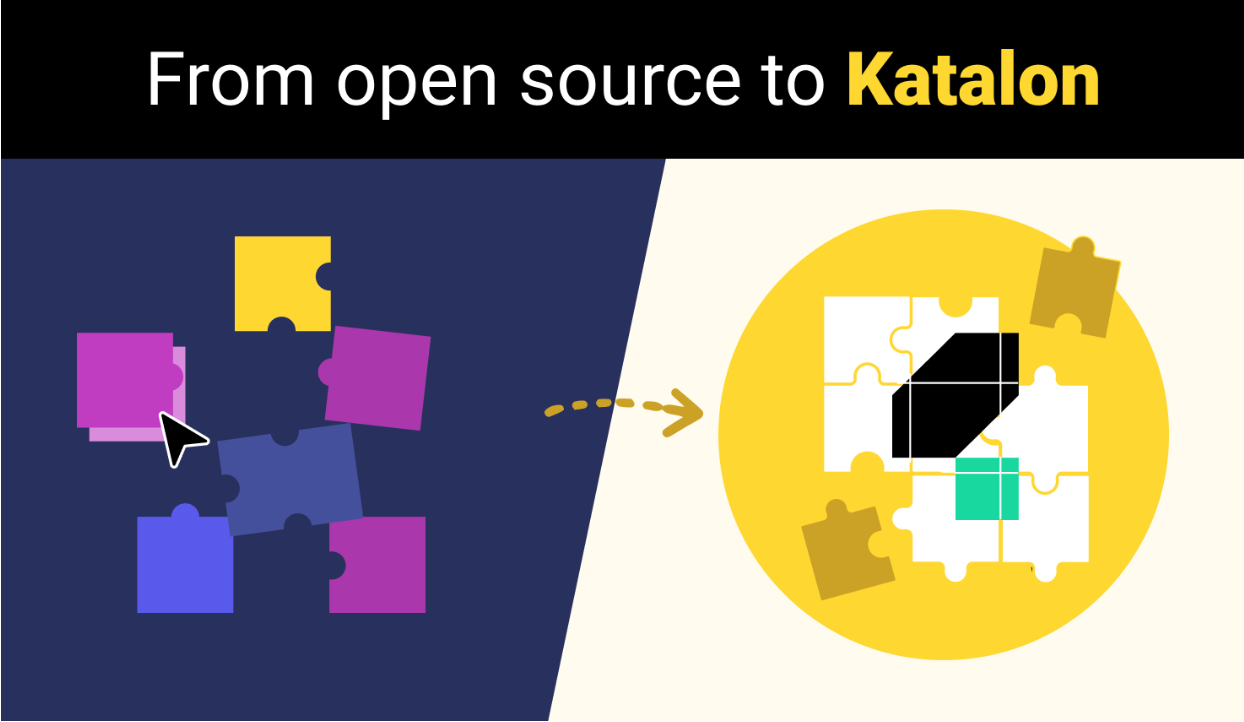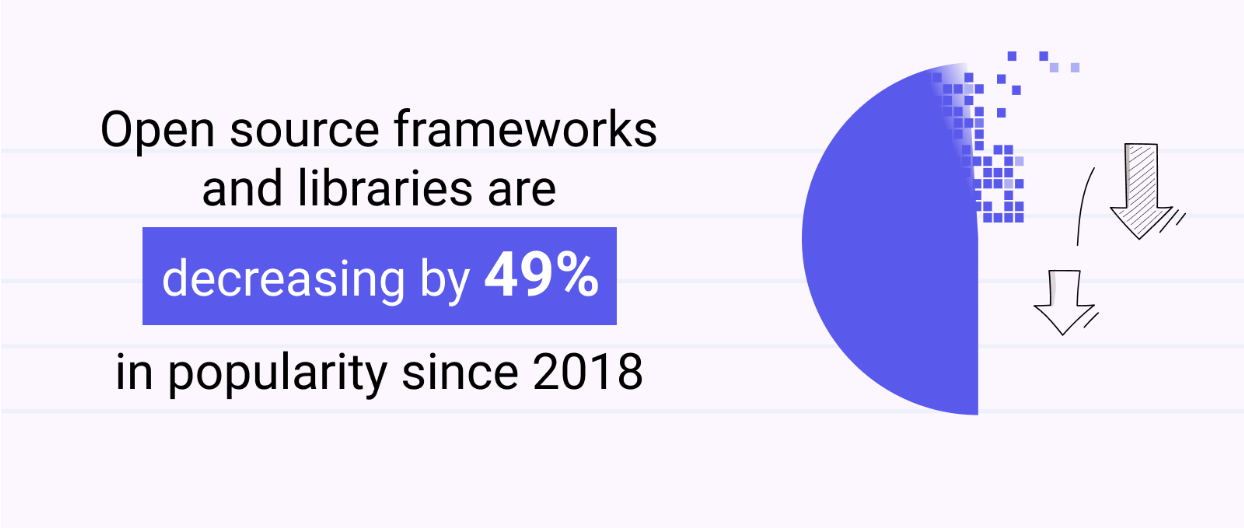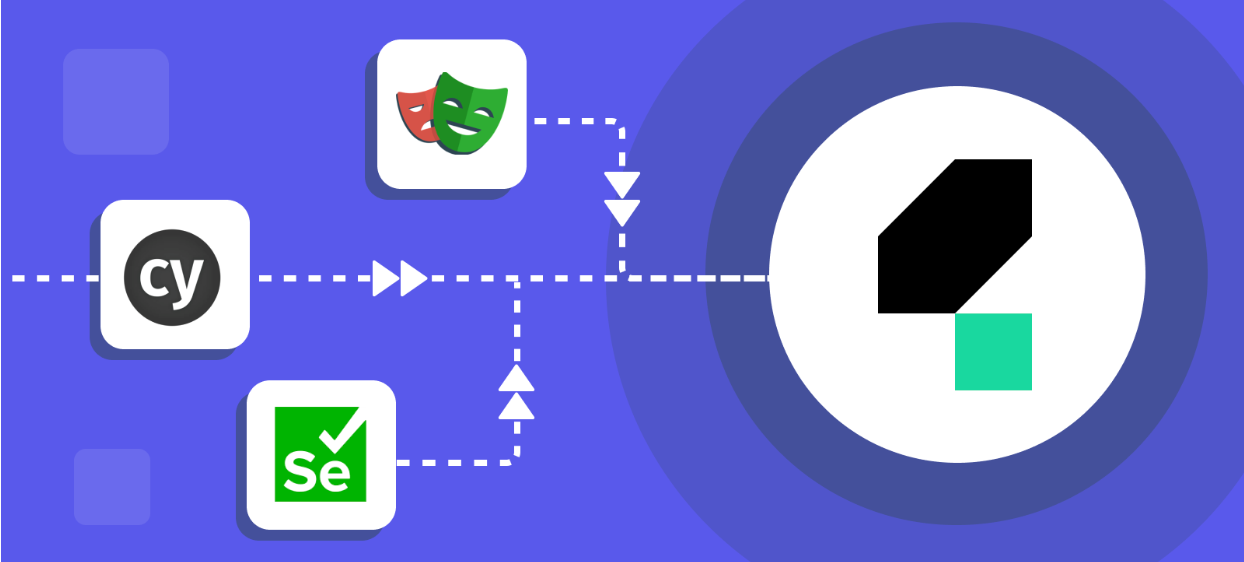From open source to Katalon

Quality confidence in the functionality of an application alone is no longer sufficient to deliver a top-notch digital experience. Customers today constantly want more, and they want it fast.
Test automation is adopted to keep up with users' tendency to be less tolerant of defects and expect quick updates and fixes at the same time.
Currently, in the automated testing tool market, open source frameworks and solutions are commonly opted for due to their flexibility and free cost of entry. But as fast becomes the new mantra and teams have to deal with more complexities in testing scenarios and scope, the pendulum has swung from open source to all-in-one, comprehensive testing solutions.
How does a quality management platform like Katalon fit into this equation? How can you achieve a seamless migration to this comprehensive platform? Read on for the answers.
The current test automation landscape
While open source tools have been a popular choice for many developers, constant advancements in the field of quality engineering have created a seismic shift in how teams should benchmark, evaluate testing tool options, and make their selections.
The growth drivers
The software space is facing rapid advancements driven by technologies such as IoT, big data, AI/ML, etc.
The wave of digital transformation has been fuelling the growth of test automation, driving the industry toward not only shipping immersive products but also scaling team productivity and maximizing efficiency. This has created several trends that have been observed:
1. Increasing demand for coverage expansion and continuous testing for confidence in product releases
The more you test, the lower the risk probability of bugs reappearing in your software (resulting in more confident releases).
An increasingly competitive market requires high-performing applications, which, in turn, asks for comprehensive and extensive testing. Expanding your test coverage is the prerequisite to ensure a confident and quality product release.
2. Shift-left by adopting the Testing Pyramid with test automation
Shifting left manifests the practice and mindset of involving quality in the early stage of the development process and applying automated tests sooner in the release cycle.
Key to this principle is the test pyramid, where tests at any level are equal in importance and priority, guiding the volume of tests at each category within the pyramid. This helps teams maintain a high-quality codebase, prevent rigorous testing and build confidence in teams' delivery.
3. Mindshift from QA (Quality Assurance) to QE (Quality Engineering) for increased efficiency and business value
While both aim at guaranteeing quality, their approaches are fundamentally different. One focuses on bug detection in the final product, and the other tries to prevent defects from happening in the first place.
In the case of QE, automated tests are incorporated right when the project kickstarts and are run in tandem (or as soon as possible) within the developing pipeline. Any issues can be spotted on the go and resolved promptly, allowing teams to streamline an uninterrupted CI/CD pipeline and agile development process.
Shifting left with test automation is the first step toward continuous end-to-end quality validation, which lays the foundation for businesses to gain operational efficiency, higher ROI and keep pace with dynamic market changes.
Read more: Software Quality Management Best Practices | 5 Do's & Don'ts
The adoption inhibitors
Accommodating such evolution of testing can’t do without tools becoming more agile and comprehensive. This is where open source tools reveal their shortcomings and limitations in scaling up teams.
According to The State of Quality Report 2022, open source frameworks' popularity is decreasing by 49%. It shows that teams are putting effort into adopting commercial tools for their comprehensiveness and ROI efficiency.

Automating with open source testing tools means adding more resources to custom code every testing utility, integration and the framework itself.
1. Technical know-how: Test automation can turn into a development project
Programming knowledge is a standard for open source test automation. But knowing how to code alone is not enough. You should also have a dedicated team that is well-versed in setting up the framework structure, and everything related, including:
- Skills and experience in both testing and programming to employ design principles such as POM and code reusability from the beginning
- Keeping the system libraries compatible with the latest release, version updates, or software changes
- Managing maintenance (tech debt, framework enhancements) activities in order not to waste precious time that could be used for expanding test coverage
Our State of Quality Report 2024 shows that 45% of respondents pointed to their team's lack of skills and experience in test automation as the top challenge, a significant increase from 37% reported in the 2023 survey. A lack of technical proficiency can either block teams from automated testing adoption right from the start or leave them with a bug-ridden tool in the end.
2. Automation stability is a challenge
DIY automation frameworks are more prone to false positives and flakiness as they are, in the end, manually set up by members who are better testers than software developers.
The open source community can provide certain levels of support and troubleshooting. However, an open source community might not be as accessible or thorough compared to support from a commercial platform.
Not to mention that the support can diminish over time (or free tools acquired) after the first release cycle, potentially leaving companies with a buggy framework and affecting their testing confidence.
3. Automate later: Tomorrow never comes
The framework setup, migration and maintenance for automated testing can be a huge turn-off. Many developers are still hesitant to try test automation or even hate it due to this very reason.
In such a scenario, vendor-based tools end up being a better solution as they enable straightforward test creation. Features such as monitoring, reporting, and object identification are already built-in, ready for you to pick up and test away.
Read more: How software quality platforms outrank single-point solutions
Several major open source market players
To further understand the mechanism behind the transition away from open source tools, let’s examine some of the key influencers, how they work, and the limitation gaps to be filled in.
Tools | Cypress | Playwright | Selenium |
What is it? | A native Javascript framework for developers and QA engineers, executes inside the browser | Node.js library for web browsers, operates directly in the browser | Library for web browser, executes outside the browser |
Key features |
|
|
|
Limitations |
|
|
|
Language support | Javascript and Typescript | Typescript, Javascript, Python, Java, and .Net | Java, C#, Python, Ruby, PHP, Perl, and Javascript |
The open source automation journey: Creating tests on open source frameworks vs. vendors
The flexibility of open source automation tools sounds attractive initially, but it comes with a price - the long-winded manual configuration and design process. Building, customizing, and maintaining the automation suite presents a technical barrier that requires a high level of effort and expertise.
The process is typically split into 2 parts:
Setting up a basic open source framework

Step 1: Install prerequisite environments
- Pre-setup for automation frameworks to function as expected.
Step 2: Download libraries and browser extensions
- Download key libraries needed (e.g., Selenium, TestNG, etc.)
- Download browser drivers (Chrome, Edge, Firefox, etc.)
Step 3: Implement design patterns
- Organize & group different objects and actions
- Organize different components (login, logoff pages etc.)
- Organize objects and actions associated
Step 4: Build basic framework
- Build page-level components
- Define object-level components
- Build actions for each object
A simple open source framework consists of 300-400+ lines of code and takes 30-50+ hours to build. It goes to show how time-consuming creating a testing framework from scratch can be, not to mention that the maintenance effort and level of training increases as the application get more complex.
And we haven't got to the testing part yet.
Creating tests on frameworks

Step 1: Create a base test case
- All expected interactions (e.g., starting a browser, parameters of behavior within a browser, timeout windows, closing a browser, etc.)
Step 2: Simple test scenario
- Creating a test scenario for an eCommerce checkout page requires knowledge of applied libraries & underlying assertions
Step 3: Verify & validate
- Perform various actions & validation checks using programming logic
Step 4: Reference & identify elements
- Significant knowledge needed to reference classes, other functions, etc. Significant manual work is required even just to interact with and inspect any element
It’s somewhat ironic that your automated testing process has to do with a lot of manual setup effort, while testing should be the main concentration.
The good news is testing doesn’t have to be this beating about the bush. With a quality management platform such as Katalon, testing is only a few steps away:
Creating tests on a quality management platform

Step 1: Set up a project
Go to File > New > Project and select your preference. Then, enter the name of your new project and the location to store the project data.

Step 2: Create a test case
In the Tests Explorer panel, right-click on the Test Case folder, select New > Test Case. Alternatively, you can also go to File > New > Test Case from the main menu.

Step 3: Verify and debug the test case
Add a verification script to the test case to know whether the login process is successful or not.

Katalon's debug mode is designed to make debugging easy to use, allowing users to quickly investigate the failure causes of the automation tests.

Step 4: Plan the test case in a test suite
Right-click on Test Suites > New > Test Suite.
Open a test suite, then select Add Test Case from the command toolbar.

Step 5: Execute the test suite and view the result
Select the Test Suite > Click Run.

You can read the full tutorial on our docs here.
Introducing the Katalon
It can’t be denied that open source automated tools are still a great option for customizing every component and module of the testing framework.
But not everyone has the time and expertise resources to get it done right. A poorly written framework can create ongoing maintenance or support headaches, lengthening the entire testing pipeline.
A tool such as Katalon is a powerful alternative that can combat these limitations. Below are the features that tackle all the major challenges of open source tools.
Low-code with built-in framework
Automation means knowing how to code, but not everyone does. Katalon’s built-in best practices and configurations let developing teams share the effort to code automation artifacts and allow manual QA to automate their testing.
Whether practicing or standardizing quality operations, a full-code/low-code testing workspace such as Katalon is key to making test automation accessible team-wide.
Katalon requires little to no upfront environment or server setup to begin automating test projects. It provides built-in project templates, test case libraries, keywords, and object repositories to simplify the learning curve for new users and help them accelerate quickly with test automation.
Unified IDE to test all apps
Complete library of web, mobile, API and desktop keywords. No more jumping from tool-to-tool for different app types.
Users can confidently apply end-to-end testing on all web, mobile, API, and desktop testing in a single project and execution flow. Similarly to Selenium, Katalon supports testing on Windows, macOS, and Linux. However, Katalon users can scale more with built-in custom keywords.
Holistic end-to-end visibility
A multitude of status/result automatic notification options through multiple collaboration channels (email, Twitter, Slack, etc.) give teams, managers and executives the visibility and insight in real-time to continuously improve the testing process.
Katalon ensures collaboration for team members while enhancing their ability to manage projects as well as keep track of executions. Users can get a holistic view from the start to the end of the project with features such as centralized data and reports, test execution planning, and pipeline optimization.
Community support
Katalon has a massive global community of users where we share best practices, facilitate learning at every level, listen to feedback, and elevate our partners and employees to engage in thought leadership throughout the industry.
It’s time to move from open source to Katalon

Changing the test automation platform doesn’t mean that you have to start everything all over again. For example, in the case of Selenium, you can import Selenium projects into Katalon with no legacy scripts wasted.
The migration process includes 3 simple steps:
- Step 1: Choose the Selenium project you want to migrate.
- Step 2: Copy and paste the source code of the chosen project to the Katalon Platform.
- Step 3: Everything is ready for you to execute and expand tests with Katalon.
However, it should be noted that Katalon only allows importing legacy scripts written in Java or Groovy. Test cases in other languages are currently not supported, so you will have to rewrite them as a result.
How Katalon supports your test migration
1. Moving from open source frameworks
Katalon's extensive, out-of-the-box integrations with top tools ensure a seamless fit into your particular quality and DevOps architecture.
You can migrate your test cases from the framework integration ecosystem, including Selenium. The supported features and keywords allow you to execute and maintain your existing projects (written in Java or Groovy) without starting everything from scratch.
Having your scripts written in Java or Groovy can secure you a headstart. Otherwise, you would be required to rewrite the test scripts if they're not already in these 2 languages.
2. 1-on-1 onboarding guide, including
- Introduction to Katalon for testers.
- Terminology and formulas.
- Setting up your workspace to start working.
- Sample project for Web Service (API), Web UI, Mobile Android/iOS, or BDD Cucumber testing.
3. Katalon is built for teams of any size and level
Manual testers can easily adapt to automation testing via the record & playback feature without much coding experience. Meanwhile, advanced testers could take their tests to a higher level via the Scripting Mode with custom keywords. This makes Katalon not only accessible and user-friendly but also highly versatile at the same time.








